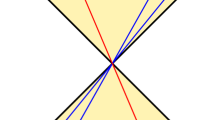Abstract
The clock hypothesis of relativity theory equates the proper time experienced by a point particle along a timelike curve with the length of that curve as determined by the metric. Is it possible to prove that particular types of clocks satisfy the clock hypothesis, thus genuinely measure proper time, at least approximately? Because most real clocks would be enormously complicated to study in this connection, focusing attention on an idealized light clock is attractive. The present paper extends and generalized partial results along these lines with a theorem showing that, for any timelike curve in any spacetime, there is a light clock that measures the curve’s length as accurately and regularly as one wishes.


Similar content being viewed by others
Notes
Throughout I use geometrical units (c=1) and the “abstract index” notation: roman super- and subscripts indicate where vector and tensor fields reside. (See, for example, Sect. 1.4 of Malament [1].)
I should emphasize that the present work is to be distinguished from that of Marzke and Wheeler [5, 6] and others following them. In those works, the authors investigate the related question of how, given that the CH holds, one can construct a clock from minimal elements. By contrast, here I am concerned instead with showing in detail that the CH holds for a particular construction.
Sachs and Wu [17] define a function Φ(p,q)=2Ω(p,q), calling it the geometric energy function, despite admitting that using the term “energy” here is somewhat misleading. Needless to say, the multiplicative factor does not materially change the results at hand.
Again, see pp. 126–127 of Sachs and Wu [17].
If p and q are null-related, there is no unit \(\bar{\xi}^{a}\), but then Ω(p,q)=0 independently of the choice of tangent vector.
If one were analyzing a concrete light clock where the spacelike unit vector \(\rho^{a} \in T_{p_{0}}M\) pointing to the “mirror” is extended to the whole image of γ, and the tangent vector ξ a is extended via Fermi–Walker transport to a neighborhood of the clock, then one can use the equation of geodesic deviation to write this curvature term as ξ a ρ c∇ c (ρ b∇ b ξ a). However, one should take care not to interpret this as an “acceleration” in any strict sense, since the derivatives are along spacelike instead of timelike geodesics.
Köhler has proved an analog of the theorem’s second limit equation for the special case of geodesics in Weyl spacetimes [19].
If one is interested in results of a more operational flavor [6], then suppose one can survey segments \(\gamma_{A}[I'_{A}]\) and \(\gamma_{B}[I'_{B}]\) of two timelike worldlines with light clocks whose scalar radius fields have similar ranges. Putting \(\overset{\alpha}{n}_{A}\) and \(\overset{\alpha}{n}_{B}\) as the bounce numbers for the two respective clocks, we have that \(\lim_{\alpha\to \infty} \overset{\alpha}{n}_{A} / \overset{\alpha}{n}_{B} = |I'_{A}|/|I'_{B}|\). That is, the ratio of bounce numbers gives in the limit the ratio of proper times of the two segments.
In fact, one should be able to relax this requirement so that the same kind of limiting relation holds if v is not constant but not varying too much, just as the theorem does with the light clock’s radial distance field r.
See Malament [1, Ch. 4] for an introduction.
References
Malament, D.B.: Topics in the Foundations of General Relativity and Newtonian Gravitation Theory. University of Chicago Press, Chicago (2012)
Bailey, J., et al.: Measurements of relativistic time dilation for positive and negative muons in a circular orbit. Nature 268, 301–305 (1977)
Mainwaring, S.R., Stedman, G.E.: Accelerated clock principles in special relativity. Phys. Rev. A 47.5, 3611–3619 (1993)
Mashhoon, B.: Measurement theory and general relativity. In: Hehl, F.W., Kiefer, C., Metzler, R.J.K. (eds.) Black Holes: Theory and Observation, pp. 269–284. Springer, Berlin (1998)
Marzke, R.F.: The Theory of Measurement in General Relativity. AB thesis, Princeton University (1959)
Marzke, R.F., Wheeler, J.A.: Gravitation as geometry—I: the geometry of space-time and the geometrodynamical standard meter. In: Chiu, H., Hoffman, W.F. (eds.) Gravitation and Relativity, pp. 40–64. Benjamin, New York (1964)
Møller, C.: Old problems in the general theory of relativity viewed from a new angle. Dan. Mat. Fys. Medd. 30.10 (1955)
Møller, C.: The ideal standard clocks in the general theory of relativity. Helv. Phys. Acta, Suppl. 4, 54–57 (1956)
Misner, C.W., Thorne, K.S., Wheeler, J.A.: Gravitation. Freeman, San Francisco (1973)
Eisele, A.M.: On the behaviour of an accelerated clock. Helv. Phys. Acta 60, 1024–1037 (1987)
Maudlin, T.: Philosophy of Physics: Space and Time. Princeton University Press, Princeton (2012)
Marder, L.: Time and the Space-Traveller. University of Pennsylvania Press, Philadelphia (1971)
Kowalski, F.V.: Accelerating light clocks. Phys. Rev. A 53.6, 3761–3766 (1996)
Gautreau, R.T.: Operational Approach to Space-Time Measurements in Relativity. Ph.D. dissertation, Stevens Institute of Technology (1966)
Anderson, J.L., Gautreau, R.: Operational formulation of the principle of equivalence. Phys. Rev. 185.5, 1656–1661 (1969)
Synge, J.L.: Relativity: the General Theory. North-Holland, Amsterdam (1960)
Sachs, R.K., Wu, H.: General Relativity for Mathematicians. Springer, New York (1977)
O’Neill, B.: Semi-Riemannian Geometry. Academic Press, San Diego (1983)
Köhler, E.: Measurement of proper time in a weyl space. Gen. Relativ. Gravit. 9.11, 953–959 (1978)
Acknowledgements
Thanks to Erik Curiel for bringing the work of Gautreau and Anderson to my attention, and to David Malament similarly for the work of Synge and for suggestions leading to the formulation of the lemma involved in the proof of the central theorem. This work was supported by a National Science Foundation Graduate Research Fellowship.
Author information
Authors and Affiliations
Corresponding author
Rights and permissions
About this article
Cite this article
Fletcher, S.C. Light Clocks and the Clock Hypothesis. Found Phys 43, 1369–1383 (2013). https://doi.org/10.1007/s10701-013-9751-3
Received:
Accepted:
Published:
Issue Date:
DOI: https://doi.org/10.1007/s10701-013-9751-3




